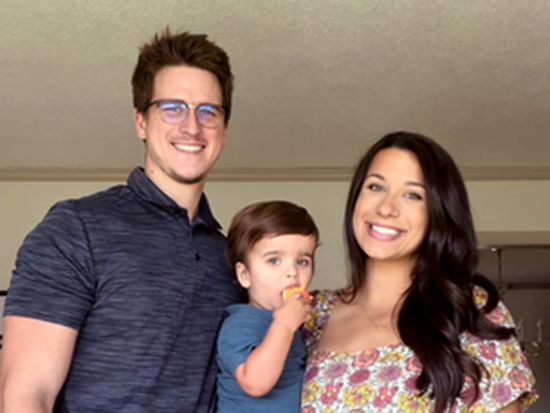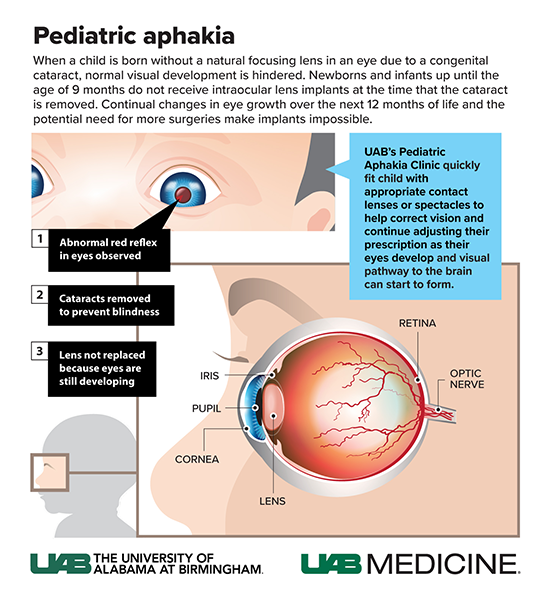Media contact: Anna Jones
 At just five months old, Kash Kennamer (middle) was diagnosed with pediatric aphakia, a rare condition in which the lens is missing from the eye.At just 5 months old, Kash Kennamer was diagnosed with pediatric aphakia, a rare condition in which the lens is missing from the eye. Fewer than 200,000 people in the U.S. have this condition according to the National Eye Institute.
At just five months old, Kash Kennamer (middle) was diagnosed with pediatric aphakia, a rare condition in which the lens is missing from the eye.At just 5 months old, Kash Kennamer was diagnosed with pediatric aphakia, a rare condition in which the lens is missing from the eye. Fewer than 200,000 people in the U.S. have this condition according to the National Eye Institute.
Kash was diagnosed with congenital cataracts at one month old. After having cataract surgery with Anne Marie Arciniegas-Bernal, M.D., at the University of Alabama at Birmingham Callahan Eye Hospital, Kash was referred to Natalie West, O.D., at UAB Eye Care’s Pediatric Aphakia Clinic — the only clinic of its kind in the state of Alabama. At this clinic, UAB optometrists and ophthalmologists work together to ensure patients with pediatric aphakia have the best vision potential as they continue to grow and develop.
“When we first learned of Kash’s diagnosis, the unknown of what this meant for him was really scary,” said Hannah Kennamer, Kash’s mother. “My husband and I drive from Huntsville so Kash can receive care, because we wanted to ensure that he would receive the best care possible. His doctors at UAB have walked us through every step of the way, and we know that he is receiving the best care possible.”
Kash’s aphakia journey began when his pediatrician found an abnormal red reflex — a pediatric screening tool often used to detect abnormalities of the eyes and ocular diseases. He was referred to an ophthalmologist, who found cataracts in both of his eyes. These cataracts can cause a child to be rendered legally blind if not taken out. However, unlike most adults who undergo cataract surgery, most infants do not receive implants to replace the natural lens of the eye because of how quickly their eyes are developing.
“After the infant has the cataracts removed, it is crucial that they get visual correction in a timely manner, typically within one to three weeks after the surgery,” Arciniegas-Bernal said. “If they do not get visual correction that quickly, the infant will never develop it. That is why it is so beneficial to have the Pediatric Aphakia Clinic at UAB, where once the infant undergoes cataract surgery, they can get fitted for the appropriate contact lenses quickly.”
Kash gets fitted for contacts every three to four months. This ability to continuously adjust a child’s contact lenses as the eye is growing plays a huge role in normal vision development.
 Click image to enlarge.
Click image to enlarge.
Graphic: Jody Potter “Since the eye is not fully developed at that age, this condition can leave patients with amblyopia, also called lazy eye, if not treated appropriately,” said West, an assistant professor at the UAB School of Optometry. “We give them contact lenses to help correct the child’s vision and continue adjusting their prescription as their eyes develop. This process gives the child the best potential for normal vision development.”
West used hard contact lenses for Kash, which are safer for babies in terms of hygiene. Kash’s parents take them out every night and put them in every morning.
“When we first heard he needed contacts, we were concerned about how he might react; but as soon as we put them in for the first time, we just celebrated, because he had the biggest smile on his face,” Hannah said. “We have learned so much about our son and his condition through all of his doctor visits and his daily eye care routine. All his doctors have been very transparent with us, and it has allowed us to trust them in taking care of our son.”
Kash currently visits UAB every three months, alternating between visiting West and Arciniegas-Bernal. He will continue visits until he is 2 or 3 years old, so they can continue to ensure normal vision development.
Although the experience has been challenging so far, Kash’s prognosis is great. In 2019, the Infant Aphakia Treatment Study reported that, for a group of 96 children who underwent cataract surgery between the ages of 1 month and 7 months old, the median visual acuity at age 5 years old was 20/45.
“While this is a great collaboration between Callahan Eye Hospital and UAB Eye Care, we could not do this without Kash’s amazing parents,” Arciniegas-Bernal said. “This process is not easy, and it can be a large emotional toll to overcome a diagnosis such as this one and to continuously commit to the process as Kash’s parents have done. They have done such a great job being supportive of their child’s care, and that plays such a vital role in this process.”